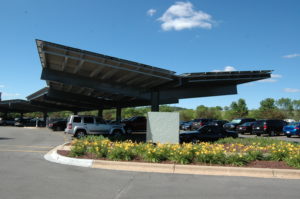EPRI, Alliant Energy Compile Results from First Year of Madison Solar Demonstration Project

A solar demonstration project at Alliant Energy’s headquarters in Madison, Wisconsin is revealing how clouds, snow, and weather affect solar photovoltaic performance in the Midwest, informing the utility’s ongoing work to incorporate solar in the electric system.
Since April 2016, more than 40 solar arrays with a combined capacity of 291 kilowatts have been generating power from which EPRI has helped gather data and analyze results.
“This project provides Alliant Energy, its customers, and the power industry with an opportunity to learn about the many ways solar can be used in the Midwest,” said Dave Sinner, product manager for customer-centric generation at Alliant Energy. “We’re sharing the data with our customers so that they can make a more informed decision about adding solar generation. We’re also sharing with other utilities, academics, and the solar industry and comparing our results against similar research in other parts of the country.”
Confirming what is well known in the solar industry, the first year’s data show that solar power generation in the Midwest is highly dependent on the weather and the season. Summer generation was the highest and the most intermittent as a result of frequent fast-moving clouds.
Winter generation was just a fraction of summer generation as a result of shorter days, many overcast days, and partial shading from snow. It was less variable, which points to the importance of considering winter performance in solar plant design and energy resource planning.
Consider snow effects, which can be minimized by focusing on panel tilt angle, orientation, and location. Steve Greidanus, an electrical engineer in Alliant Energy’s Generation Engineering Group, said that accumulated snow reduced generation by 30–80% on some arrays. For steeply tilted ground-mounted systems, snow was gone the day after a storm. Roof-mounted arrays with lower angles remained under drifts for several days.
This video shows how snow and ice impact the power generation from a southeast-facing solar array with a 35-degree tilt. On the chart at left, irradiance refers to the sunlight the array receives, and power is what the array produces. The closing gap between the two lines indicates that as the snow and ice melt, the array generates more power relative to available sunlight.
For Madison, the optimal array orientation to capture more winter sunlight and maximize annual generation is south-facing at a 35-degree angle. Lower angles maximized summer production. Southeast- and southwest-facing arrays generated less power overall but produced higher output earlier or later in the day.
“In Wisconsin, demand spikes between 3 and 5 p.m., so many customers without south-facing roofs would be best suited with a west-facing array to offset more load,” said Sinner.
Initial data for a dual-axis tracking ground-mounted array indicate that it can produce up to 44% more energy than fixed-tilt systems. Researchers expect to test two recently installed single-axis tracking arrays in the coming year.
“Tracking increases capital costs but also increases production, which can reduce the levelized cost of electricity. This benefit is most pronounced at sites with high-quality solar resources,” said EPRI Senior Technical Leader Cara Libby. “Prior EPRI research has shown that the performance gains from trackers outweigh the higher upfront costs in some locations such as the desert southwest, but not in all locations.”
As costs for trackers come down, their economics will improve in more locations, leading to more deployment. Today, 70% of ground-mount solar arrays are installed with trackers.

“Although tracking generates more energy throughout the year compared with fixed-tilt systems, the steeper ramp-up of morning power and ramp-down of evening power can present grid-integration challenges,” said Libby. “This project is exploring opportunities to support efficient integration of solar using short-term forecasting and battery storage systems.”
Following two years of data collection, Alliant Energy plans to analyze long-term generation trends. Alliant Energy can use the results of the demonstration, coupled with weather station and sky imaging data, to predict generation potential in the Midwest and determine how best to deploy solar in its service territory.
Alliant and EPRI provide a publicly accessible online dashboard of the demonstration’s real-time and historical data.
Additional Results of Madison Demonstration Project
- 30% of sunlight in Madison comes in the form of diffuse light, including light that is scattered due to atmospheric particles and reflected from the ground, clouds, and other nearby objects. This percentage is typical for an area with frequent partly cloudy days.
- Solar carports with downspouts and gutters in the center (see photo above) provide safety for people and cars underneath, but they are not ideal configurations for shedding snow.
- There was a wide range of performance among the various panel technologies (polycrystalline silicon, cadmium telluride, monocrystalline silicon, copper indium gallium selenide, and hybrids), depending on weather, temperature, and other seasonal effects.
EPRI Technical Expert:
Cara Libby

